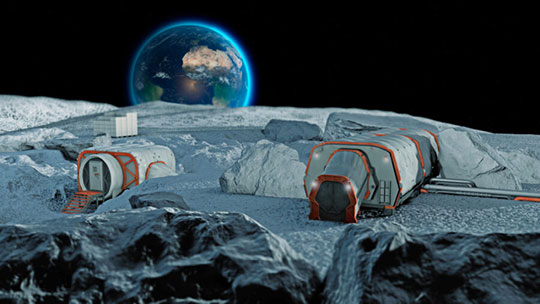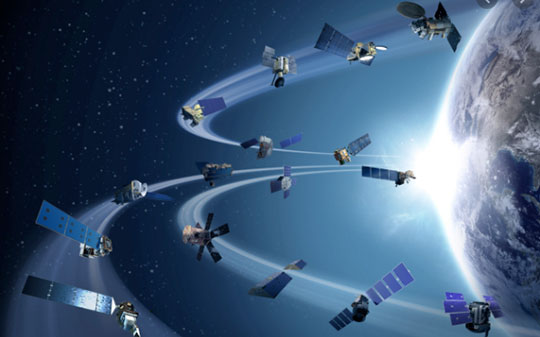
What will it take for missions to the Moon to be more than just visits? Constellations spoke with Al Tadros, Chief Technology Officer at Redwire about the upcoming Artemis missions, human and robotic exploration on the Moon and beyond, and the space infrastructure needed to enable it.
Tadros pointed out that NASA has led “a lot of firsts in space, the first time we go somewhere, the first time we image or collect data,”. This time, 50 years after its Apollo landing, NASA’s upcoming Artemis missions are all about collaboration with commercial and international partners. The ambitions to explore more of the lunar surface and establish the first long-term presence on the Moon are a transition, Tadros said, “from NASA-led and NASA-only, to commercial-contributed, commercial-included, commercial profit-making,”.
The pivot to involvement beyond NASA is about sustainability, a word that comes up often, in order to spur on new industries, business establishment, economic returns and profitability.
He underscored that sustainability also refers to the innovative infrastructure needed to make that long term presence a reality.
It is the difference, Tadros said, between “setting up a tent on a lot and actually putting up a building, with construction equipment, cranes, laying a foundation… showing that you're planning to be there.”
Comparing an exploration mission to a colony or a settlement means literally laying out the infrastructure that goes along with it, including, he said, “a power grid with solar arrays, radiation shielding, thermal protection, habitats, landing pads, all the things that you would expect from a city that's going to exist for a while.”
That includes not just what is on the Moon, but also everything in the environment between Moon and Earth, referring to the cislunar environment. “Cislunar recognizes the fact that we can't have an economy on the Moon without being able to operate between the Earth and the Moon consistently, that the Earth and the Moon are part of an ecosystem that we have to work in, in order to make it sustainable. A lot of things have to happen for a sustainable presence on the Moon. It's the transportation, it's the depot-ing, it's the positioning, it's the launching and landing.”
The NASA Gateway is a central part of the ecosystem. It is the way station or habitat in lunar orbit that astronauts will be able to go to before they venture down to the Moon. It will then allow them to come back up in a vehicle, dock, and return to Earth.
A Cue from Earth
Tadros said there needs to be the kind of infrastructure and systems on and around the Moon that we take for granted on Earth, “from communications, cell towers, GPS, as well as the ability to power it all.”
“We take GPS for granted, but we need an equivalent system on the Moon. So you can expect that that will be part of the orbiting and the lunar surface infrastructure in order to make it survivable and livable and sustainable,” Tadros said.
Infrastructure on the Moon, like on Earth, will include terminals to communicate directly back to Earth, up to the Gateway as part of the Artemis architecture supporting the Artemis Orion capsules, as well as for communications on the lunar surface.
“Just like we have cell towers here on Earth, there will be communications systems to support all the rovers, for the crewed and uncrewed vehicles, for the habitats, for the explorers, all of that. And that's a critical piece that has to be deployed almost before we send a whole lot of people and robots out there,” Tadros said.
A Power Plant in Space
And like the gear and infrastructure on Earth, it will all need sufficient power to operate.
Similar to the power that runs buildings and cities, Tadros explained the plan to establish a power grid on the surface of the Moon that can provide near unlimited sustainable power through solar generation.
The technology, referred to as ‘roll out solar arrays’ or ROSAs, is used on the Space Station, generating over 50 kilowatts of power. The public has seen images of it deployed by astronauts.
Similar to solar panels on a roof, or the large panel farms out on a field, the arrays operate more like large spaced-based beach blankets that must be unfurled to soak up energy from the sun. One challenge, Tadros said, is building large efficient arrays in a way that can be transported into space. He explained how the cells are folded up to fit in the small confines of the rocket faring, then rolled out once in orbit.
The ROSAs will be deployed on the Moon as well as on the gateway, powering the station’s electric propulsion so it can maintain orbit and communicate to the lunar surface and back to Earth.
“It's a huge benefit to the space missions to be able to use large amount of power in space,” Tadros said. That the arrays can be retracted, relocated and redeployed, is part of the sustainability. “You want to put the power where you need it and with solar panels, you can do that.”
But unlike Earth, space is far more harsh and challenging to engineer for. “You might think that your rooftop is an extreme environment for solar panels, but space is another layer,” Tadros said. “The surface of the Moon is actually some of the hottest and the coldest location in the solar system without an atmosphere. Those are some of the technical challenges that engineers love to work and solve, so we are doing that.”

Traffic management
Another facet not to be overlooked is safety. With the frequency of launches and increased cislunar activity expected in coming years, Tadros spoke of the importance of space domain awareness, likening it to air traffic management on Earth. “The reality is there's a lot of in-space motion or space-to-space relocation of satellites. And so space domain awareness includes understanding not only what's in space, but also the motivations and capabilities,” he said.
“You can know that there's an airplane in the air, but knowing whether it's a 747 or a Cessna, what kind of range it has, where it can land, how fast it can go, all these things that make it a sustainable air traffic management system is part of what we need so that we can all operate safely and reliably.”
While the next phase of human activity in space and more complex missions is generating excitement, it is all part of the learning curve, advancing what is learned on and around the Moon to take the next giant leap: sending the first astronauts to Mars.
Click here to listen to the full interview.
